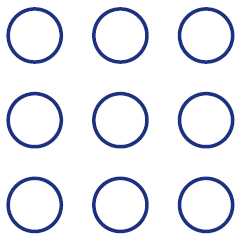This problem solving activity has a number (addition and subtraction) focus.

- all different sums
- all the same sums
- all even sums
- all odd sums
What is the biggest and smallest side sums that you can make?
- Recall basic addition facts to 20.
- Investigate odd and even numbers.
- Devise and use problem solving strategies (guess and check, act it out, draw a picture).
This problem provides the opportunity for the students to apply their addition facts knowlege in an interesting situation. It also reinforces their understanding of odd and even numbers and combinations these. Students can be encouraged to notice that an odd + odd = even, even + even = even, odd + even = odd.
Guessing and checking is likely to be the most used strategy in finding solutions to this problem. In each part, students can be encouraged to answer the question, 'is that the only solution?'
The Problem

- all different sums
- all the same sums
- all even sums
- all odd sums
What is the biggest and smallest side sums that you can make?
Teaching Sequence
- Introduce the problem to the class – you could do this by asking a student to select a digit card from a "hat" and record the number in one of the circles. Ask another student to select a number and record it. Continue until the circles are full and then ask the students to make statements about it.
- Read the problem with the students – make sure that they understand that they are to use each of the numbers 1- 9, once only. Students should write the sums outside of the grid, next to the relevant 'side' of the grid.
- Get the students to work on the problem individually or in pairs. Encourage the students to look for patterns in the combination of odd and even numbers as they solve parts c and d.
- Share answers to each of the parts of the problems. Ask the students to make statements about the combination of odd and even numbers.
Extension
Arrange numbers so that all the rows and columns have the same sum. How many ways can you do this?
Solution
There are many possible answers to the first two parts of the problem. We give some of these below. One way to do the first one might be to try 1 in the top left corner, 2 in the next column to it and 3 in the top right corner. If we keep putting the numbers in systematically, intuition tells us that the top and bottom rows will be different.
1 2 3 (6)
4 5 6
7 8 9 (24)
(12) (18)
To get all the sides the same, we could try to put the small numbers in the corners and balance them up with the larger numbers.
1 8 3
9 7 5
2 6 4
That may take a bit of experimenting. You need to make sure that 1 and 4 are not on the same side.
Both examples we've used so far have even sums on the side. To find some odd sums we'll put the small numbers in the corners but in order this time.
1 6 2
5 9 7
3 8 4
Once we've put in 1, 2, 3 and 4 it's just a matter of choosing an odd number in the sides where the sum is already even and an even number where the sum is already odd.
Note:
The only ways to get an odd row are to sum 2 evens and an odd or 3 odds.
- even odd even
- odd odd odd
- even odd even
Solution to the extension
The digits from 1-9 sum to a total of 45, so the total of all three rows (or columns) must be 45. Therefore, for them all to be equal the sum of each must be 15.
The digits can be arranged in a square with every row and column (and diagonal) summing to 15 like this:
8 1 6
3 5 7
4 9 2
This arrangement can be reflected or rotated and still work.
If any two rows are swapped, or if any two columns are swapped, the rows and columns will all still have equal sums, but the diagonals will not.